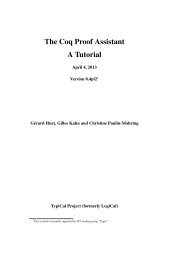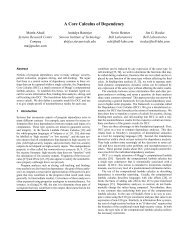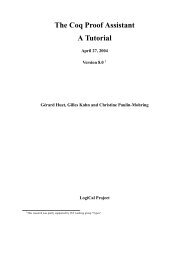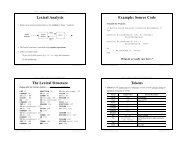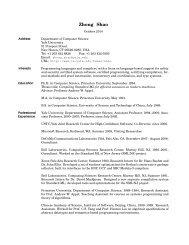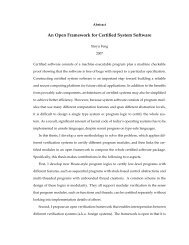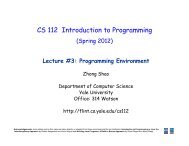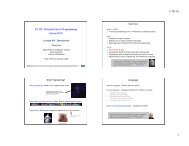A Translation from Typed Assembly Languages to ... - Yale University
A Translation from Typed Assembly Languages to ... - Yale University
A Translation from Typed Assembly Languages to ... - Yale University
You also want an ePaper? Increase the reach of your titles
YUMPU automatically turns print PDFs into web optimized ePapers that Google loves.
A <strong>Translation</strong> <strong>from</strong> <strong>Typed</strong> <strong>Assembly</strong> <strong>Languages</strong> <strong>to</strong><br />
Certified <strong>Assembly</strong> Programming<br />
Zhaozhong Ni 1 Zhong Shao 2<br />
1 Microsoft Research, One Microsoft Way<br />
Redmond, WA 98052, U.S.A.<br />
zhaozhong.ni@microsoft.com<br />
2 Department of Computer Science,<strong>Yale</strong> <strong>University</strong><br />
New Haven, CT 06520-8285, U.S.A.<br />
shao@cs.yale.edu<br />
Abstract. <strong>Typed</strong> assembly languages (TAL) and certified assembly programming<br />
(CAP) are two techniques for low-level verifications. TAL uses syntactic<br />
types and typing rules for program specification and reasoning, while CAP uses<br />
Hoare-style logic assertions and semantic subsumptions. They are suitable for<br />
different kinds of verification tasks. Previously, programs verified in either one of<br />
them can not interoperate freely with the other, making it hard <strong>to</strong> integrate them<br />
in<strong>to</strong> a complete system. Moreover, the relationship between TAL and CAP lines<br />
of work has not been discussed extensively.<br />
In this paper, we do so by presenting a translation <strong>from</strong> a TAL language <strong>to</strong> a CAP<br />
language. The translation involves an intermediate step of a “semantic” TAL language.<br />
To better illustrate our key points, all three languages share a same untyped<br />
machine. Thus the shape of the source language is slightly different <strong>from</strong> the<br />
original TAL’s. Nevertheless, it supports polymorphic code, mutable reference,<br />
existential, and recursive types. The target language is an extension of XCAP, a<br />
recent CAP language, with support of logical recursive specifications and logical<br />
mutable reference, both require minimal changes <strong>to</strong> XCAP and its meta theory.<br />
Since we proved typing preservation for the translation, there is a clear path <strong>to</strong><br />
link and interoperate well-typed programs <strong>from</strong> traditional certifying compilers<br />
with certified libraries by CAP-like systems.<br />
1 Introduction<br />
Proof-carrying code (PCC) [1] is a general framework that can, in principle, verify<br />
safety properties of arbitrary machine-language programs. Existing PCC systems [2–5],<br />
however, have focused on programs written in type-safe languages [6, 7] or variants of<br />
typed assembly languages (TAL) [8]. Type-based approaches are attractive because they<br />
facilitate au<strong>to</strong>matic generation of the safety proofs (by using certifying compilers) and<br />
provide great support <strong>to</strong> modularity and higher-order language features. But they also<br />
suffer <strong>from</strong> several serious limitations. First, types are not expressive enough <strong>to</strong> specify<br />
sophisticated invariants commonly seen in the verification of low-level system software.<br />
Recent work on logic-based type systems [9–13] have made types more expressive but<br />
they still cannot specify advanced state invariants and assertions [14–16] definable in
a general-purpose predicate logic with inductive definitions [17]. Second, type systems<br />
are <strong>to</strong>o weak <strong>to</strong> prove advanced properties and program correctness, especially in the<br />
context of concurrent assembly code [15, 18]. Finally, different style languages often<br />
require different type systems, making it hard <strong>to</strong> reason about interoperability.<br />
An alternative <strong>to</strong> type-based methods is <strong>to</strong> use Hoare logic [19, 20]—a widely applied<br />
technique in program verification. Hoare logic supports formal reasoning using<br />
very expressive assertions and inference rules <strong>from</strong> a general-purpose logic. In the context<br />
of foundational proof-carrying code (FPCC) [21, 22], the assertion language is often<br />
unified with the mechanized meta logic (following Gordon [23])—proofs for Hoare<br />
logic consequence relation and Hoare-style program derivations are explicitly written<br />
out in a proof assistant. For example, Touchs<strong>to</strong>ne PCC [24] used Hoare-style assertions<br />
<strong>to</strong> express complex program invariants. Appel et al [25, 26] used Hoare-style state<br />
predicates <strong>to</strong> construct a general semantic model for machine-level programs. Shao et<br />
al [22, 16, 18, 27] recently developed a certified assembly programming (CAP) framework<br />
that uses Hoare-style reasoning <strong>to</strong> verify low-level system libraries and general<br />
multi-threaded assembly programs.<br />
TAL and CAP are suitable for different kinds of verification tasks. Previously, programs<br />
verified in either one of them can not interoperate freely with the other, making it<br />
hard <strong>to</strong> integrate them in<strong>to</strong> a complete system. Moreover, the relationship between TAL<br />
and CAP lines of work has not been discussed extensively.<br />
In this paper we compare the type-based and logic-based methods by presenting a<br />
type-preserving translation <strong>from</strong> a TAL language <strong>to</strong> a CAP langyage. The translation<br />
involves an intermediate step of a “semantic” TAL language. Our translation supports<br />
polymorphic code, mutable reference, existential, and recursive types. The target language<br />
is an extension of XCAP [27], a recent CAP language which supports embedded<br />
code pointers and impredicative polymorphisms. We added <strong>to</strong> XCAP the support<br />
of logical recursive specifications and logical mutable reference, both require minimal<br />
changes <strong>to</strong> XCAP and its meta theory, and call our new language XCAP+. Since we<br />
proved typing preservation for the translation <strong>from</strong> TAL <strong>to</strong> XCAP+, there is a clear<br />
path <strong>to</strong> link and interoperate well-typed programs <strong>from</strong> traditional certifying compilers<br />
with certified libraries by CAP-like systems.<br />
We present the paper in the order of source language TAL (Sec 2), intermediate<br />
language STAL (Sec 3), and target language XCAP+ (Sec 4). Then we present the<br />
complete translation and the type-preservation properties (Sec 5). Finally we do some<br />
brief discussion and conclude (Sec 6).<br />
2 Source Language: TAL<br />
In this section we present a typed assembly language (TAL). To make the comparison<br />
easier, we build all languages in this paper on a common target machine. Throughout<br />
the paper, we also assume an underlying mechanized meta logic like<br />
(Prop) p,q ::= True | False | ¬p | p ∧ q | p ∨ q | p ⊃ q | ∀x:A. p | ∃x:A. p | ...
(Program) P ::= (C,S,I)<br />
(State) S ::= (H,R)<br />
(Heap) H ::= {l ❀ w} ∗<br />
(RegFile) R ::= {r ❀ w} ∗<br />
(Register) r ::= {rk} k∈{0...31}<br />
(Word,Labels) w,f,l ::= i (nat nums)<br />
(CodeHeap) C ::= {f ❀ I} ∗<br />
(InstrSeq) I ::= c;I | jd f | jmp r<br />
(Command) c ::= bgti r s ,i,f | addi r d ,r s ,i<br />
| add r d ,r s ,r t<br />
| movi r d ,i | mov r d ,r s<br />
| ld r d ,r s (i) | st r d (i),r s<br />
Fig. 1. Syntax of target machine TM<br />
if I = then (C,(H,R),I) ↦−→<br />
jd f (C,(H,R),C(f)) when f∈dom(C)<br />
jmp r (C,(H,R),C(R(r))) when R(r)∈dom(C)<br />
bgti r s ,i,f;I ′ (C,(H,R),I ′ ) when R(r s )≤i; (C,(H,R),C(f)) when R(r s )>i<br />
c;I ′ (C,Nextc(H,R),I ′ )<br />
if c = then Nextc(H,R) =<br />
add r d ,r s ,r t (H,R{r d ❀R(r s )+R(r t )})<br />
mov r d ,r s (H,R{r d ❀R(r s )})<br />
movi r d ,i (H,R{r d ❀i})<br />
ld r d ,r s (i) (H,R{r d ❀H(R(r s )+i)}) when R(r s )+i ∈ dom(H)<br />
st r d (i),r s (H{R(r d )+i❀R(r s )},R) when R(r d )+i ∈ dom(H)<br />
Fig. 2. Operational semantics of TM<br />
2.1 Target Machine (TM)<br />
We define the syntax and the operational semantics of the target abstract machine (TM)<br />
in Fig 1. A complete TM program consists of a code heap, a dynamic state component<br />
made up of the register file and data heap, and an instruction sequence. The instruction<br />
set is minimal but extensions are straightforward. To control the complexity of the paper,<br />
we ignore the allocation of memory. The register file is made up of 32 registers and<br />
the data heap can potentially be infinite. The operational semantics of this language (see<br />
Fig 2) should pose no surprise. Note that it is illegal <strong>to</strong> access undefined heap locations,<br />
or jump <strong>to</strong> a code label that does not exist; under both cases, the execution gets “stuck.”<br />
2.2 <strong>Typed</strong> <strong>Assembly</strong> Language (TAL)<br />
The TAL language presented here follows the principle of the original typed assembly<br />
languages [8]. However, due <strong>to</strong> the usage of an untyped raw machine, the shape of<br />
typing judgments and rules are slightly different.<br />
Fig 3 presents the type definitions in TAL. Machine word is classified as of value<br />
type (τ) including integer, code, tuple, existential package, and recursive data structures.<br />
A code heap specification (Ψ) is a partial environment that maps a code label <strong>to</strong> a<br />
“precondition” type ([∆].Γ) for its corresponding code block. Here ∆ is a type variable<br />
environment and Γ is a register file type which specifies the type for each register.
Ψ ⊢{[∆].Γ}P<br />
(Well-formed Program)<br />
⊢ C:Ψ Ψ ⊢ S:[∆].Γ Ψ ⊢{[∆].Γ}I<br />
⊢ C:Ψ<br />
Ψ ⊢{[∆].Γ}(C,S,I)<br />
(Well-formed Code Heap)<br />
Ψ ⊢{Ψ(f)}C(f) ∀f∈dom(Ψ)<br />
(CDHP)<br />
⊢ C:Ψ<br />
(PROG)<br />
(CdHpSpec) Ψ ::= {f ❀ [∆].Γ} ∗<br />
(RfileTy) Γ ::= {r ❀ τ} ∗<br />
(TyVarEnv) ∆ ::= · | α,∆<br />
(WordTy) τ ::= α | int | code[∆].Γ<br />
| 〈τ 1 ,...,τ n 〉 | ∃α.τ<br />
| µα.τ<br />
(DtHpSpec) Φ ::= {l ❀ τ} ∗<br />
Ψ ⊢{[∆].Γ}I<br />
(Well-formed Instruction Sequence)<br />
⊢{Γ}c{Γ ′ } Ψ ⊢{[∆].Γ ′ }I<br />
c∈{add,mov,movi,ld,st}<br />
Ψ ⊢{[∆].Γ}c;I<br />
(SEQ)<br />
f∈dom(Ψ)<br />
Ψ ⊢{[∆].Γ{r d ❀code Ψ(f)}}I<br />
Ψ ⊢{[∆].Γ}movi r d ,f;I<br />
(MOVF)<br />
f∈dom(Ψ)<br />
Ψ ⊢{[∆].Γ}jd f<br />
⊢ [∆].Γ ≤ Ψ(f)<br />
(JD)<br />
Γ(r)=code[∆ ′ ].Γ ′ ⊢ [∆].Γ ≤ [∆ ′ ].Γ ′<br />
Ψ ⊢{[∆].Γ}jmp r<br />
(JMP)<br />
f∈dom(Ψ) Γ(r s )=int<br />
Ψ ⊢{[∆].Γ}I ⊢ [∆].Γ ≤ Ψ(f)<br />
Ψ ⊢{[∆].Γ}bgti r s ,i,f;I<br />
(BGTI)<br />
⊢ [∆].Γ ≤ [∆ ′ ].Γ ′ Ψ ⊢{[∆ ′ ].Γ ′ }I<br />
Ψ ⊢{[∆].Γ}I<br />
(WEAKEN)<br />
Fig. 3. Type definitions and <strong>to</strong>p-level static semantics of TAL<br />
Similarily, a data heap specification (Φ) is a partial environment that maps <strong>from</strong> a data<br />
label <strong>to</strong> a value type for its corresponding heap cell.<br />
The <strong>to</strong>p-level semantic rules of TAL are also presented in Fig 3. A program is wellformed<br />
if each of its components is. For a code heap <strong>to</strong> be well-formed, each block in it<br />
must be well-formed. The intuition behind well-formed instruction sequence judgment<br />
is that if the state satisfies the precondition [∆].Γ, then executing I is safe with respect<br />
<strong>to</strong> Ψ. Weakening is allowed <strong>to</strong> turn one precondition in<strong>to</strong> another provided that they<br />
satisfy the subtyping relation. A instruction sequence c;I is safe if one can find another<br />
register file type which serves as both the post-condition of c and the precondition of I.<br />
A direct jump is safe if the current precondition implies the precondition of the target<br />
code block specified in Ψ. An indirect jump is safe when the target register is of a code<br />
type with a weaker precondition. Constant code labels can be moved in<strong>to</strong> registers.<br />
The remaining typing rules for TAL is presented in Fig 4. Valid subtypings include<br />
reducing the registers, instantiation of code type, packing, unpacking, folding, and unfolding.<br />
For simple instructions, their pre- and post-conditions do not involve change<br />
of type variable environment, thus we only specify the register file types before and<br />
after their execution. The well-formed state rule instantiates the current type variable<br />
environment and requires a current data heap specification <strong>to</strong> be supplied and checked.<br />
Other judgments and rules are standard and straight-forward.
⊢ [∆].Γ ≤ [∆ ′ ].Γ ′<br />
(Subtyping)<br />
∆ ⊇ ∆ ′ ∀ r ∈ dom(Γ ′ )<br />
Γ(r)=Γ ′ (r) ∆ ′ ⊢ Γ ′ (r)<br />
⊢ [∆].Γ ≤ [∆ ′ ].Γ ′<br />
(SUBT)<br />
Γ(r)=τ[τ ′ /α] ∆ ⊢ τ ′<br />
⊢ [∆].Γ ≤ [∆].Γ{r:∃α.τ} (PACK)<br />
Γ(r)=τ[µα.τ/α]<br />
⊢ [∆].Γ ≤ [∆].Γ{r:µα.τ} (FOLD)<br />
Γ(r)=code[α,∆ ′ ].Γ ′ ∆ ⊢ τ ′<br />
⊢ [∆].Γ ≤ [∆].Γ{r:code[∆ ′ ].Γ ′ [τ ′ /α]} (TAPP)<br />
Γ(r)=∃α.τ<br />
⊢ [∆].Γ ≤ [α,∆].Γ{r:τ} (UNPACK)<br />
Γ(r)=µα.τ<br />
⊢ [∆].Γ ≤ [∆].Γ{r:τ[µα.τ/α]} (UNFOLD)<br />
⊢{Γ}c{Γ ′ }<br />
(Well-formed Instruction)<br />
Γ(r s ) = int<br />
⊢{Γ}addi r d ,r s ,i{Γ{r d :int}} (ADDI)<br />
⊢{Γ}movi r d ,w{Γ{r d :int}} (MOVI)<br />
Γ(r s ) = Γ(r t ) = int<br />
⊢{Γ}add r d ,r s ,r t {Γ{r d :int}} (ADD)<br />
Γ(r s ) = τ<br />
⊢{Γ}mov r d ,r s {Γ{r d :τ}} (MOV)<br />
Γ(r s )=〈τ 1 ,...,τw+1,...,τ n 〉<br />
⊢{Γ}ld r d ,r s (w){Γ{r d :τw+1}} (LD) Γ(r d )=〈τ 1 ,...,τw+1,...,τ n 〉 Γ(r s )=τw+1<br />
⊢{Γ}st r d (w),r s {Γ}<br />
(ST)<br />
∆ ⊢ τ Ψ ⊢ S:[∆].Γ Ψ ⊢ H:Φ Ψ;Φ ⊢ R:Γ Ψ;Φ ⊢ w:τ<br />
(Well-formed Type, State, Heap, Register file, and Word)<br />
FTV (τ)⊆∆<br />
∆ ⊢ τ<br />
(TYPE)<br />
· ⊢ τ i ∀ i Ψ ⊢ H:Φ Ψ;Φ ⊢ R:Γ[τ 1 ,...,τ n /α 1 ,...,α n ]<br />
Ψ ⊢ (H,R):[α 1 ,...,α n ].Γ<br />
(STATE)<br />
Ψ;Φ ⊢ H(l):Φ(l) ∀ l∈dom(Φ)<br />
Ψ ⊢ H:Φ<br />
(HEAP)<br />
Ψ;Φ ⊢ R(r):Γ(r) ∀ r∈dom(Γ)<br />
Ψ;Φ ⊢ R:Γ<br />
(RFILE)<br />
Ψ;Φ ⊢ w:int<br />
(INT)<br />
f∈dom(Ψ)<br />
Ψ;Φ ⊢ f:code Ψ(f) (CODE) · ⊢ τ ′ Ψ;Φ ⊢ f:code[α,∆].Γ<br />
Ψ;Φ ⊢ f:code[∆].Γ[τ ′ /α]<br />
(POLY)<br />
Φ(l+i−1)=τ i ∀ i<br />
Ψ;Φ ⊢ l:〈τ 1 ,...,τ n 〉 (TUP) · ⊢ τ ′ Ψ;Φ ⊢ w:τ[τ ′ /α]<br />
Ψ;Φ ⊢ w:∃α.τ<br />
(EXT)<br />
Ψ;Φ ⊢ w:τ[µα.τ/α]<br />
Ψ;Φ ⊢ w:µα.τ<br />
(REC)<br />
Fig. 4. Static semantics of TAL (continued)<br />
The soundness theorem guarantees that given a well-formed program, the machine<br />
will never get stuck. It is proved following the syntactic approach of proving type soundness<br />
[28]. We also list a few key lemmas below.<br />
Theorem 1 (TAL Soundness). If Ψ ⊢{[∆].Γ}P, then for all natural number n, there<br />
exists a program P ′ such that P ↦−→ n P ′ .
Lemma 1 (State Weakening).<br />
If Ψ ⊢ S:[∆].Γ and ⊢ [∆].Γ ≤ [∆ ′ ].Γ ′ then Ψ ⊢ S:[∆ ′ ].Γ ′ .<br />
Lemma 2 (Instruction Typing).<br />
If Ψ ⊢ S:[∆].Γ and ⊢ {Γ}c{Γ ′ } then Ψ ⊢ Nextc(S):[∆].Γ ′ .<br />
3 A “Semantic” TAL Language<br />
Instead of doing translation <strong>from</strong> TAL <strong>to</strong> CAP directly, we create a new “Semantic”<br />
TAL language (STAL) <strong>to</strong> serve as an intermediate step between them. Let us revisit the<br />
static semantics of TAL in Figure 4 and the lemmas used in TAL soundness proof.<br />
First look at the set of subtyping rules between preconditions (⊢ [∆].Γ ≤ [∆ ′ ].Γ ′ ).<br />
If we also look at the State Weakening lemma (Lemma 1) in TAL soundness proof,<br />
it is easy <strong>to</strong> see that all of those syntactic rules are just used for the meta implication<br />
between the two state typings in the soundness proof. Given a mechanized meta logic,<br />
we can replace these rules with a single one,<br />
Ψ ⊢ S:[∆].Γ ⊃ Ψ ⊢ S:[∆ ′ ].Γ ′<br />
⊢ [∆].Γ ≤ [∆ ′ ].Γ ′<br />
∀ S,Ψ<br />
(SUBT)<br />
which explicitly requests the meta implications between two state typing. By doing so,<br />
not only did we remove the fixed syntactic subtyping rules <strong>from</strong> TAL, but the State<br />
Weakening lemma is no longer part of the soundness proof. More importantly, the<br />
subtyping between preconditions is no longer limited <strong>to</strong> the built-in rules. Any valid<br />
implication relation between state typing is allowed. This is much more flexible and<br />
powerful.<br />
Now let us look at the set of instruction typing rules (⊢ {Γ}c{Γ ′ }). Also look at<br />
the Instruction Typing lemma (Lemma 2) in TAL soundness proof. Again all these<br />
syntactic rules are just used for the meta implication between two state typings in the<br />
soundness proof. (The difference this time is that the two states are now different and<br />
are states before and after the execution of an instruction.) Applying our trick again, we<br />
can replace these rules with a single one,<br />
Ψ ⊢ S:[∆].Γ ⊃ Ψ ⊢ Nextc(S):[∆].Γ ′<br />
⊢ {Γ}c{Γ ′ }<br />
∀ S,Ψ<br />
(INSTR).<br />
We also successfully removed the fixed syntactic instruction typing rules as well as he<br />
Instruction Typing lemma <strong>from</strong> TAL. The new form of instruction typing is much more<br />
flexible and powerful.<br />
Of course, in composing the actual meta proof supplied <strong>to</strong> the new SUBT and IN-<br />
STR rules, it is most likely that those disappeared lemmas will still be used. Neverthless,<br />
making them separated <strong>from</strong> the type language and its meta theory is important because<br />
it reduces the size of the type language, as well as allows more flexible reasoning. By<br />
introducing meta implication in<strong>to</strong> TAL, we made one step forward so now there is a<br />
mixture of syntactic types and logic proofs.
We call this version of TAL a semantic TAL (STAL). STAL and TAL share the<br />
exactly same syntax and <strong>to</strong>p-level static semantics, as well as the same state and value<br />
typing rules (The remaining of Figure 4). While STAL has much more reasoning power<br />
than TAL do, the soundness of STAL are simpler than TAL’s. Nevertheless, instead<br />
of merely supplying type signatures <strong>to</strong> their code, now the programmers have <strong>to</strong> also<br />
supply actual meta logic proof.<br />
As an intermediate step <strong>from</strong> TAL <strong>to</strong>ward CAP, STAL only upgrades TAL’s expressiveness<br />
by using general logic implications in the subtyping and instruction typing<br />
rules. STAL program specifications are still fullly syntactic types and thus are not as<br />
expressive as general logic predicate.<br />
It is obvious <strong>to</strong> obtain the following TAL <strong>to</strong> STAL typing translation theorm. (we<br />
ignore the cases of those judgments where TAL and STAL share the exactly same rules.)<br />
Theorem 2 (Typing Preservations <strong>from</strong> TAL <strong>to</strong> STAL).<br />
1. if ⊢ TAL [∆].Γ ≤ [∆ ′ ].Γ ′ then ⊢ STAL [∆].Γ ≤ [∆ ′ ].Γ ′ ;<br />
2. if ⊢ TAL {Γ}c{Γ ′ } then ⊢ STAL {Γ}c{Γ ′ }.<br />
4 Target Language: XCAP+<br />
4.1 XCAP: A Certified <strong>Assembly</strong> Programming Language<br />
Certified assembly programming (CAP) [15] is logic-based verification framework for<br />
assembly code. Recently, XCAP [27], a language following CAP, was proposed <strong>to</strong> solve<br />
the problem of modular support of higher-order features like embedded code pointers<br />
(ECPs) and impredicative polymorphisms. This paper uses XCAP as the base language<br />
for the target of translation <strong>from</strong> TAL.<br />
Figure 5 defines the core of the XCAP specification language called extended logical<br />
propositions (PropX). PropX can be viewed as a lifted version of the meta logic<br />
propositions, extended with an cptr constant <strong>to</strong> specify ECPs. PropX can be used <strong>to</strong><br />
construct assertions on machine states. For example, <strong>to</strong> specify that r1, r2, and r3 s<strong>to</strong>re<br />
the same value, we write λ(H,R).〈R(r1)=R(r2) ∧ R(r 2 )=R(r3)〉. We also define<br />
code heap specifications and assertion subsumption (⇒) accordingly.<br />
To establish the validity of extended propositions, XCAP defines a set of inductively<br />
defined validity rules in Figure 6. The judgment, Γ ⊢ Ψ P, means that P is valid under<br />
environment Γ (a set of extended propositions) and code heap specification Ψ. The<br />
introduction rules of lifted proposition 〈p〉 and ECP proposition cptr(f,a) require that<br />
p and Ψ(f) = a be valid in the meta logic. The interpretation of extended propositions<br />
is defined as their validity under the empty environment: [[P]] Ψ · ⊢ Ψ P.<br />
We present the XCAP inference rules also in Figure 5. Comparing <strong>to</strong> TAL’s <strong>to</strong>p-level<br />
static semantics, we can see that they share similar structures. This is convenient for the<br />
later translation. Due <strong>to</strong> space constraint, we only explain the rules that are different<br />
<strong>from</strong> TAL.<br />
In the <strong>to</strong>p level rule, the current state is checked upon the interpretation of current<br />
assertion. For simple instructions, we require the pre- and post-condition satisfy the
Ψ ⊢{a}P<br />
(Well-formed Program)<br />
⊢ C:Ψ ([[a]] Ψ S) Ψ ⊢{a}I<br />
⊢ C:Ψ<br />
Ψ ⊢{a}(C,S,I)<br />
(Well-formed Code Heap)<br />
(PROG)<br />
Ψ ⊢{Ψ(f)}C(f) ∀f∈dom(Ψ)<br />
(CDHP)<br />
⊢ C:Ψ<br />
Ψ ⊢{a}I<br />
(Well-formed Instruction Sequence)<br />
(CdH pSpec) Ψ ::= {f❀ a} ∗<br />
(Assertion) a<br />
∈ State → PropX<br />
(PropX) P,Q ::= 〈p〉 | cptr(f,a)<br />
| P ∧Q | P ∨Q | P →Q<br />
| ∀x:A.P | ∃x:A.P<br />
| ∃α:A→PropX.P<br />
[[a]] Ψ λS.[[a S]] Ψ<br />
a⇒a ′ ∀Ψ,S.[[a]] Ψ S⊃[[a ′ ]] Ψ S<br />
a ⇒c a ′ ∀Ψ,S.[[a]] Ψ S⊃[[a ′ ]] Ψ Nextc(S)<br />
a ⇒c a ′ Ψ ⊢{a ′ }I<br />
c∈{add,mov,movi,ld,st}<br />
Ψ ⊢{a}c;I<br />
(SEQ)<br />
(λS.cptr(f,Ψ(f)) ∧a S) ⇒ a ′<br />
f∈dom(Ψ) Ψ ⊢{a ′ }I<br />
Ψ ⊢{a}I<br />
(ECP)<br />
a ⇒ Ψ(f)<br />
Ψ ⊢{a}jd f<br />
f∈dom(Ψ)<br />
(JD)<br />
a ⇒ (λ(H,R).a ′ (H,R) ∧ cptr(R(r),a ′ ))<br />
Ψ ⊢{a}jmp r<br />
(JMP)<br />
(λ(H,R).〈R(r s )≤i〉 ∧ a (H,R)) ⇒ a ′ Ψ ⊢{a ′ }I<br />
(λ(H,R).〈R(r s )>i〉 ∧ a (H,R)) ⇒ Ψ(f) f∈ dom(Ψ)<br />
Ψ ⊢{a}bgti r s ,i,f;I<br />
Fig. 5. Assertion language and inference rules for XCAP<br />
(BGTI)<br />
Γ ⊢ Ψ P (Validity of Extended Propositions) (The following omits the Ψ in Γ ⊢ Ψ P.)<br />
(env) Γ := · | Γ,P<br />
P ∈ Γ<br />
Γ ⊢P (ENV)<br />
p<br />
Γ ⊢〈p〉 (〈〉-I) Γ ⊢〈p〉 p ⊃ (Γ ⊢Q)<br />
Γ ⊢Q<br />
(〈〉-E)<br />
Ψ(f)=a<br />
Γ ⊢cptr(f,a) (CP-I) Γ ⊢cptr(f,a) (Ψ(f)=a)⊃(Γ ⊢Q)<br />
Γ ⊢Q<br />
(CP-E)<br />
Γ ⊢P Γ ⊢Q<br />
Γ ⊢P∧Q<br />
( ∧-I)<br />
Γ ⊢P∧Q<br />
Γ ⊢P<br />
( ∧-E1)<br />
Γ ⊢P∧Q<br />
Γ ⊢Q<br />
( ∧-E2)<br />
Γ ⊢P<br />
Γ ⊢P∨Q ( ∨-I1)<br />
Γ ⊢Q<br />
Γ ⊢P∨Q ( ∨-I2)<br />
Γ ⊢P∨Q Γ,P ⊢R Γ,Q ⊢R<br />
Γ ⊢R<br />
( ∨-E)<br />
Γ,P ⊢Q<br />
Γ ⊢P→Q ( →-I)<br />
Γ ⊢P→Q Γ ⊢P<br />
Γ ⊢Q<br />
( →-E)<br />
Γ ⊢P[B/x] ∀ B:A<br />
Γ ⊢ ∀x:A.P<br />
( ∀-I1)<br />
Γ ⊢ ∀x:A.P B:A<br />
Γ ⊢P[B/x]<br />
( ∀-E1)<br />
B:A Γ ⊢P[B/x]<br />
Γ ⊢ ∃x:A.P<br />
( ∃-I1)<br />
Γ ⊢ ∃x:A.P Γ,P[B/x] ⊢Q ∀ B:A<br />
Γ ⊢Q<br />
( ∃-E1)<br />
a:A→PropX Γ ⊢P[a/α]<br />
Γ ⊢ ∃α:A→PropX.P<br />
( ∃-I2)<br />
Fig. 6. Validity rules for extended propositions (PropX)
weakest precondition relation. Direct jump is safe as long as the target code’s precondition<br />
is weaker than the current one. For indirect jump, the current precondition has <strong>to</strong><br />
guarantee that the target address is a well-formed code label with a weaker precondition.<br />
The ECP rule allows one <strong>to</strong> introduce new ECP propositions about any labels in<br />
the code heap specification in<strong>to</strong> the new assertion.<br />
Consistency of PropX interpretation, “[[〈False〉]] Ψ is not provable,” is merely a<br />
corollary of the following theorem.<br />
Theorem 3 (Soundness of PropX Interpretation).<br />
1. If [[〈p〉]] Ψ then p;<br />
2. if [[cptr(f,a)]] Ψ then Ψ(f) = a;<br />
3. if [[P ∧Q]] Ψ then [[P]] Ψ and [[Q]] Ψ ;<br />
4. if [[P ∨Q]] Ψ then either [[P]] Ψ or [[Q]] Ψ ;<br />
5. if [[P →Q]] Ψ and [[P]] Ψ then [[Q]] Ψ ;<br />
6. if [[ ∀x:A.P]] Ψ and B:A then [[P[B/x]]] Ψ ;<br />
7. if [[ ∃x:A.P]] Ψ then there exists B:A such that [[P[B/x]]] Ψ ;<br />
8. if [[ ∃α:A→PropX.P]] Ψ then there exists a:A→PropX such that [[P[a/α]]] Ψ .<br />
The soundness of XCAP is also proved in the similar way as for TAL.<br />
Theorem 4 (XCAP Soundness). If Ψ ⊢{a}P, then for any natural number n, there<br />
exists a program P ′ such that P↦−→ n P ′ .<br />
In the following sections, we present two extensions <strong>to</strong> XCAP. These extensions<br />
only change the assertion language and do not alter the structure of XCAP. As a result,<br />
soundness and many other meta properties of XCAP easily hold. Our extensions, including<br />
the validity soundness and XCAP soundness theorems, have been mechanized<br />
in Coq Proof Assistant [17]. Our implementation is available at [29].<br />
4.2 Supporting Logical Recursive Specifications<br />
Recursive specifications are very useful in describing complex invariants. Simple recursive<br />
data structures such as link-list are already supported by XCAP. However, for the<br />
recursive types (µα.τ) found in TAL, their counterpart in logic, “recursive predicates”,<br />
can not be easily defined in XCAP. We add a piece of syntax <strong>to</strong> PropX <strong>to</strong> support<br />
recursive predicates and use syntactic methods <strong>to</strong> establish their validities.<br />
We define the recursive predicate construc<strong>to</strong>r as below.<br />
(PropX) P,Q ::= ... | (µ α:A→ PropX.λx:A.P B)<br />
To understand the formation of recursive predicate, let us start <strong>from</strong> the innermost<br />
proposition P. λx:A.P is a predicate of type A → PropX. So µα : A → PropX.λx:A.P<br />
is meant <strong>to</strong> be a recursive predicate of type A → PropX, which corresponds <strong>to</strong> recursive<br />
types found in type systems. Since the basic unit of definition is extended proposition<br />
instead of extended predicate, we apply it with a term B of type A, and make
(µ α:A→ PropX.λx:A.P B) the basic shape of recursive predicates formula. When using<br />
recursive predicates formulas, we often use its predicate form, and use the notation<br />
µα:A → PropX.λx:A.P <strong>to</strong> represent predicate λy:A.(µ α:A→ PropX.λx:A.P y).<br />
To establish validity of recursive predicate formulas, we add the following rule <strong>to</strong><br />
the validity rules in Figure 6. It is essentially a fold rule for recursive types.<br />
B:A<br />
Γ ⊢ P[B/x][µα:A → PropX.λx:A.P/α]<br />
Γ ⊢ (µ α:A→ PropX.λx:A.P B)<br />
(µ-I)<br />
We extend PropX interpretation soundness (Theorem 3) with the following case:<br />
If [[(µ α:A→ PropX.λx:A.P B)]] Ψ then [[P[B/x][µα:A → PropX.λx:A.P/α]]] Ψ .<br />
4.3 Supporting Logical mutable reference<br />
Weak update (also termed as “mutable reference” or “general references”) is a commonly<br />
used memory mutation model. Examples of weak update include ML reference<br />
cells (int ref) and managed data pointers (int gc*) in .NET common type system. In<br />
the weak update model, each memory cell’s values must satisfy a certain fixed value<br />
type. The tuple type in TAL (such as the one <strong>to</strong> be shown in next section) is also a weak<br />
update reference cell types.<br />
Unfournately, weak update is not well-supported by CAP and other Hoare-logicbased<br />
PCC systems. The problem is due <strong>to</strong> the lack of a global data heap invariant<br />
that local assertions about heap cells can be checked upon. Existing Hoare-logic-based<br />
PCC systems either avoid supporting weak update [24, 16], limit the assertions (for<br />
reference cells) <strong>to</strong> types only [30], or resort <strong>to</strong> heavyweight techniques that require the<br />
construction of complex semantic models [26, 31]. In this section we present a weak<br />
update extension of the XCAP using the similar syntactic technique for ECPs.<br />
We add a reference cell proposition ref(l,t) <strong>to</strong> the extended propositions. It associates<br />
word type t (a value predicate) with data label l.<br />
(PropX) P,Q ::= ... | ref(l,t)<br />
(WordTy) t ∈ Word → PropX<br />
We can use the following macro <strong>to</strong> describe a record of n cells.<br />
record(l,t 1 ,...,t n ) ref(l,t 1 ) ∧ ... ∧ref(l+n−1,t n )<br />
To testify the validity of reference cell propositions, in the interpretation [[P]] Ψ,Φ<br />
we need an additional “data heap specification” parameter Φ which, similar <strong>to</strong> the code<br />
heap specification Ψ, is a partial mapping <strong>from</strong> data labels <strong>to</strong> word types.<br />
(DtHpSpec) Φ ::= {l ❀ t} ∗<br />
To establish validity of ref(l,t), data label l and word type t need <strong>to</strong> be in Φ.<br />
Φ(l)=t<br />
Γ ⊢ Ψ,Φ ref(l,t) (RF-I) Γ ⊢ Ψ,Φ ref(l,t) (Φ(l)=t)⊃(Γ ⊢Q)<br />
Γ ⊢ Ψ,Φ Q<br />
(RF-E)
Validity rules of other cases remain unchanged other than taking an extra Φ argument.<br />
Validity soundness of those cases also holds, with the following additional case.<br />
If [[ref(l,t)]] Ψ,Φ then Φ(l) = t;<br />
Different <strong>from</strong> code heap, the data heap is dynamic. Its specification can not be obtained<br />
statically. Instead, we need <strong>to</strong> find it out in each execution steps. So the assertion<br />
interpretation is changed <strong>to</strong>:<br />
[[a]] Ψ λ(H,R).∃Φ,H s ,H w .H=H s ⊎H w ∧ [[a (H s ,R)]] Ψ,Φ ∧ DH Ψ Φ H w<br />
There should exist a data heap specification Φ describing the weak update part of current<br />
data heap. Other than checking validity of (a (H,R)) using Ψ and Φ, we also needs<br />
<strong>to</strong> checking validity of Φ.<br />
For a data heap specification Φ <strong>to</strong> be valid, each reference cell must contains value<br />
that matches its word type.<br />
DH Ψ Φ H ∀l∈dom(Φ)=dom(H).[[Φ(l) H(l)]] Ψ,Φ<br />
Based on the weak update memory model defined above, we can derived many<br />
useful “macro” inference rules below. These rules can help guide the proof process by<br />
the programmer. (insens(a,r) asserts predicate is insensitive <strong>to</strong> register r, i.e., does not<br />
talk about register r. Its definition is omitted here.)<br />
Ψ ⊢{(λ(H,R).a(H,R) ∧t R(r d ))}I insens(a,r d )<br />
Ψ ⊢{(λ(H,R).a(H,R) ∧ref(R(r s )+w,t))}ld r d ,r s (w);I (W-LD)<br />
Ψ ⊢{a}I<br />
Ψ ⊢{(λ(H,R).a(H,R) ∧ref(R(r d )+w,t) ∧t R(r s ))}st r d (w),r s ;I (W-ST)<br />
To avoid confusion, we call the XCAP language plus the logical recursive specification<br />
and logical mutable reference extension as the XCAP+ language, which serves<br />
as the target language of the translation.<br />
Example Below is a “mini object”, using the recursive predicates and weak update<br />
extensions presented in previous sections.<br />
classs c {<br />
void f (c x) { x.f(x) }<br />
}<br />
c µ α:Word →PropX.λx:Word.ref(x, λy:Word.cptr(y, λ(H,R).(α R(r1))))<br />
The above example may looks similar <strong>to</strong> what one would normally write in a syntactic<br />
type system. However, given the ability <strong>to</strong> write general logic predicate in the<br />
sepcifications, it is possible <strong>to</strong> compose very interesting data structures and properties.<br />
Below is an example: a record pointer l which points <strong>to</strong> an even number, a data pointer<br />
<strong>to</strong> a reference cell s<strong>to</strong>ring an odd number, and a code pointer which, among other things,<br />
expects register r 1 <strong>to</strong> be an unaliased pointer <strong>to</strong> a prime number. (↦→ and ∗ are separation<br />
logic connectives which can be build in XCAP using shallow embedding.)<br />
record(l, even, λw.ref(w,odd), λw.cptr(w, λ(H,R).(∃w.R(r 1 )↦→w ∧ prime w) ∗ ...))
<strong>Translation</strong> <strong>from</strong> TAL WordTy <strong>to</strong> XCAP+ WordTy<br />
int λw.True<br />
code[∆].Γ λw.codeptr(w,[∆].Γ)<br />
〈τ 1 ,...,τ n 〉 λw.record(w,τ 1 ,...,τ n )<br />
∃α.τ λw. ∃α:Word →PropX.τ<br />
µα.τ λw.(µ α:Word →PropX.λx:Word.(τ x) w)<br />
<strong>Translation</strong> <strong>from</strong> TAL Precondition <strong>to</strong> XCAP+ Assertion<br />
[α 1 ,...,α m ].{r 1 ❀τ 1 ,...,r n ❀τ n }<br />
λ(H,R). ∃α 1 ,...,α m : Word →PropX.(τ 1 R(r 1 )) ∧ ... ∧(τ n R(r n ))<br />
<strong>Translation</strong> <strong>from</strong> TAL CdHpSpec <strong>to</strong> XCAP+ CdHpSpec<br />
{l 1 ❀[∆ 1 ].Γ 1 ,...,l n ❀[∆ n ].Γ n } {l 1 ❀[∆ 1 ].Γ 1 ,...,l n ❀[∆ n ].Γ n }<br />
<strong>Translation</strong> <strong>from</strong> TAL DtHpSpec <strong>to</strong> XCAP+ DtHpSpec<br />
{l 1 ❀τ 1 ,...,l n ❀τ n } {l 1 ❀τ 1 ,...,l n ❀τ n }<br />
Fig. 7. Type translations <strong>from</strong> TAL/STAL <strong>to</strong> XCAP+<br />
5 A <strong>Translation</strong> <strong>from</strong> TAL/STAL <strong>to</strong> XCAP+<br />
We first give a translation <strong>from</strong> TAL/STAL types <strong>to</strong> XCAP+ assertions. We then show<br />
the type-preserving property of the STAL <strong>to</strong> XCAP+ translation. Finally we do some<br />
brief discussion of the translation.<br />
5.1 Type <strong>Translation</strong>s <strong>from</strong> TAL/STAL <strong>to</strong> XCAP+<br />
We present the type translations <strong>from</strong> TAL <strong>to</strong> XCAP+ in Figure 7. Various · translate<br />
TAL types in<strong>to</strong> XCAP+ assertions and specifications.<br />
In the word type translation, integer type becomes a tau<strong>to</strong>logy as any machine word<br />
can be treated as an integer. Code type is translated in<strong>to</strong> ECP formulas. Tuple types in<br />
TAL is translated in<strong>to</strong> record type in XCAP+. Existential types and recursive types in<br />
TAL are also translated in<strong>to</strong> their XCAP+ counterparts.<br />
The translation of a TAL precondition, which is a type variable environment plus<br />
a register file type, is an XCAP+ assertions. The type variables in the environment<br />
are now existentially quantified over XCAP+ word types at the outmost of the target<br />
assertion. The register file typing corresponds <strong>to</strong> a bunch of conjunction of register<br />
value checking.<br />
The translations of TAL code and data heap specifications are carried out by simply<br />
translating each element’s type in them in<strong>to</strong> XCAP+ assertions or word types, and<br />
preserving the partial mapping.
5.2 Typing Preservations <strong>from</strong> TAL/STAL <strong>to</strong> XCAP+<br />
An important property of the previous type translations is whether they preserve the<br />
typing, i.e., whether well-formed TAL/STAL entities are still well-formed in XCAP+<br />
after the translation. As the following typing preservation lemma show, all STAL typing<br />
derivations gets preserved in XCAP+ after the translations.<br />
Theorem 5 (Typing Preservations <strong>from</strong> STAL <strong>to</strong> XCAP+).<br />
1. If Ψ ⊢ STAL {[∆].Γ}P then Ψ ⊢ XCAP+ {[∆].Γ}P;<br />
2. if ⊢ STAL C:Ψ then ⊢ XCAP+ C:Ψ;<br />
3. if Ψ ⊢ STAL {[∆].Γ}I then Ψ ⊢ XCAP+ {[∆].Γ}I;<br />
4. if Ψ ⊢ STAL S:[∆].Γ then [[[∆].Γ]] Ψ<br />
S;<br />
5. if Ψ ⊢ STAL H:Φ then DH Ψ Φ H;<br />
6. if Ψ;Φ ⊢ STAL R:Γ then [[[].Γ (H,R)]] Ψ,Φ<br />
;<br />
7. if Ψ;Φ ⊢ STAL w:τ then [[τ w]] Ψ,Φ<br />
;<br />
8. if ⊢ STAL [∆].Γ ≤ [∆ ′ ].Γ ′ then [∆].Γ ⇒ [∆ ′ ].Γ ′ ;<br />
9. if ⊢ STAL {Γ}c{Γ ′ } then [∆].Γ Ψ ⇒c [∆].Γ ′ .<br />
Proof. We show selected cases for (3). By induction over the structure of Ψ ⊢ TAL {[∆].Γ}I.<br />
⊢ [∆].Γ ≤ [∆ ′ ].Γ ′ Ψ ⊢{[∆ ′ ].Γ ′ }I<br />
case WEAKEN.<br />
Ψ ⊢{[∆].Γ}I<br />
By induction hypothesis it follows that Ψ ⊢ XCAP+ {[∆ ′ ].Γ ′ }I. The following weakening<br />
lemma easily holds for XCAP+: “if Ψ ⊢{a ′ }I and a ⇒ a ′ then Ψ ⊢{a}I”. By (8)<br />
it follows that [∆].Γ ⇒ [∆ ′ ].Γ ′ . Thus it follows that Ψ ⊢ XCAP+ {[∆].Γ}I.<br />
Ψ ⊢{Γ}c{Γ ′ } Ψ ⊢{[∆].Γ ′ }I c∈{add,mov,movi,ld,st}<br />
case SEQ.<br />
Ψ ⊢{[∆].Γ}c;I<br />
By induction hypothesis it follows that Ψ ⊢ XCAP+ {[∆].Γ ′ }I. By (9) it follows<br />
that [∆].Γ Ψ ⇒c [∆].Γ ′ . By rule SEQ it follows that Ψ ⊢ XCAP+ {[∆].Γ}c;I.<br />
f∈dom(Ψ) ⊢ [∆].Γ ≤ Ψ(f)<br />
case JD.<br />
Ψ ⊢{[∆].Γ}jd f<br />
By (8) it follows that [∆].Γ ⇒ Ψ(f), and then [∆].Γ ⇒ Ψ(f). By rule JD<br />
it follows that Ψ ⊢ XCAP+ {[∆].Γ}jd f.<br />
Γ(r)=code[∆ ′ ].Γ ′ ⊢ [∆].Γ ≤ [∆ ′ ].Γ ′<br />
case JMP.<br />
Ψ ⊢{[∆].Γ}jmp r<br />
By translation it follows that [∆].Γ ⇒ λ(H,R).cptr(R(r),[∆ ′ ].Γ ′ ). By (8) it follows<br />
that [∆].Γ ⇒ [∆ ′ ].Γ ′ . By rule JMP it follows that Ψ ⊢ XCAP+ {[∆].Γ}jmp r.<br />
f∈dom(Ψ) Ψ ⊢{[∆].Γ{r d ❀code Ψ(f)}}I<br />
case MOVF.<br />
Ψ ⊢{[∆].Γ}movi r d ,f;I<br />
By induction hypothesis it follows that Ψ ⊢ XCAP+ {[∆].Γ{r d ❀code Ψ(f)}}I.<br />
By rule ECP and SEQ it follows that Ψ ⊢ XCAP+ {[∆].Γ}movi r d ,f;I.
5.3 Discussion<br />
We discussed the relationship between TAL and CAP by showing a translation <strong>from</strong><br />
TAL <strong>to</strong> XCAP+. However, this work is by no means limited <strong>to</strong> the translation itself.<br />
For example, one can treat the translation as a shallow embeddeding of TAL types<br />
and typing rules in XCAP+, which means there is no need <strong>to</strong> build meta theory for TAL<br />
while still letting the programmer working at TAL level.<br />
One interesting perspective <strong>to</strong> view the XCAP+ system is <strong>from</strong> TAL programmer’s<br />
side. When writting programs that will interact with XCAP+ code that involve complex<br />
logical specification not expressible in TAL, so long as the interfaces abstract and hide<br />
that part of “real” logical specification (e.g., by using existential packages), and local<br />
code behavior is simple enough (which is usually the case), the programmers can “pretend”<br />
that they are dealing with external TAL code instead of XCAP+ ones, by using<br />
the macros and lemmas defined for the translations. This lowers the requirement on programmers,<br />
as they do not need <strong>to</strong> learn XCAP+, even if they are dealing with external<br />
XCAP+ code.<br />
6 Related Work and Conclusion<br />
Hamid and Shao [30] introduced an Extensible TAL with Runtime System (XTAL) and<br />
showed its translation <strong>to</strong> an earlier version of Certified <strong>Assembly</strong> Programming. Their<br />
main goal is <strong>to</strong> make sure the translation result can interoperate with the run-time system<br />
written and verified in CAP and thus form a complete FPCC proof. Since CAP does not<br />
have modular support of embedded code pointer and weak update, the translation there<br />
can not be merely <strong>from</strong> XTAL value types <strong>to</strong> CAP predicates, but rather needs XTAL<br />
heap types as well. This requires both the source type systems and programs <strong>to</strong> be fixed.<br />
Chen et al [4] have developed LTAL, a low-level typed assembly language which<br />
is used <strong>to</strong> compile core ML <strong>to</strong> FPCC. LTAL is based in turn upon an abstraction layer,<br />
TML (typed machine language) [32], which is an even lower-level intermediate language.<br />
Complex parts of the semantic proofs, such as the indexed model of recursive<br />
types and stratified model of mutable fields, are hidden in the soundness proof of TML.<br />
Recently, Appel et al [33] proposed a new modal model for expressing recursive and<br />
impredicatively quantified types with mutable reference. Their method uses a Kripke<br />
semantics of the Godel-Lob logic of provability. To support mutable reference, they<br />
include the memory mapping information in the “world”. A full comparison between<br />
the CAP/XCAP line of work and the line of index-based semantic FPCC work will be<br />
an interesting yet non-trivial problem. Here we are only going <strong>to</strong> list a few of them.<br />
First, CAP is designed <strong>to</strong> support more than ”type safety” at each program point.<br />
The code heap specification specifies the safety policy in general logic predicates, and<br />
is completely cus<strong>to</strong>mizable. Meta theory of CAP guarantees that these safety policy<br />
is actually observable. While in indexed FPCC work, the definition of “codeptr” has<br />
always been based on a non-stuckness safety. It remains unclear how <strong>to</strong> change the<br />
definition of “codeptr” in order <strong>to</strong> support cus<strong>to</strong>mizable and observable safety policies<br />
without rebuilding the meta theory.
Second, CAP is designed <strong>to</strong> support directly verifying assembly programs with<br />
non-trivial properties not expressible in traditional types. Various examples of CAP<br />
programs has been mechanically certified [22, 16, 18, 27]. While the indexed FPCC<br />
work has been focusing on type-preserving compilations <strong>from</strong> high-level languages,<br />
thus have few application of direct verification at assembly level. The translation presented<br />
in this paper is one effort on connecting CAP/XCAP with high-level languages.<br />
Conclusion We presented a type-preserving translation <strong>from</strong> a TAL language <strong>to</strong> a CAP<br />
language. Our translation supports polymorphic code, mutable reference, existential,<br />
and recursive types. To do so, we used an intermediate “semantic” TAL language. We<br />
also extended the XCAP language <strong>to</strong> support logical recursive specifications and mutable<br />
references. Our result will lead <strong>to</strong> linking and inter-operating well-typed programs<br />
<strong>from</strong> traditional certifying compilers with certified libraries by CAP-like systems.<br />
References<br />
1. Necula, G.: Proof-carrying code. In: Proc. 24th ACM Symposium on Principles of Programming<br />
<strong>Languages</strong>, New York, ACM Press (1997) 106–119<br />
2. Colby, C., Lee, P., Necula, G., Blau, F., Plesko, M., Cline, K.: A certifying compiler for Java.<br />
In: Proc. 2000 ACM Conference on Programming Language Design and Implementation,<br />
New York, ACM Press (2000) 95–107<br />
3. Hamid, N.A., Shao, Z., Trifonov, V., Monnier, S., Ni, Z.: A syntactic approach <strong>to</strong> foundational<br />
proof-carrying code. In: Proc. 17th Annual IEEE Symposium on Logic in Computer<br />
Science. (2002) 89–100<br />
4. Chen, J., Wu, D., Appel, A.W., Fang, H.: A provably sound tal for back-end optimization.<br />
In: Proc. 2003 ACM Conference on Programming Language Design and Implementation,<br />
ACM Press (2003) 208–219<br />
5. Crary, K.: Toward a foundational typed assembly language. In: Proc. 30th ACM Symposium<br />
on Principles of Programming <strong>Languages</strong>. (2003) 198<br />
6. Gosling, J., Joy, B., Steele, G.: The Java Language Specification. Addison-Wesley (1996)<br />
7. Milner, R., Tofte, M., Harper, R., MacQueen, D.: The Definition of Standard ML (Revised).<br />
MIT Press, Cambridge, Massachusetts (1997)<br />
8. Morrisett, G., Walker, D., Crary, K., Glew, N.: From System F <strong>to</strong> typed assembly language.<br />
In: Proc. 25th ACM Symposium on Principles of Programming <strong>Languages</strong>, ACM<br />
Press (1998) 85–97<br />
9. Xi, H., Pfenning, F.: Dependent types in practical programming. In: Proc. 26th ACM Symposium<br />
on Principles of Programming <strong>Languages</strong>, ACM Press (1999) 214–227<br />
10. Shao, Z., Saha, B., Trifonov, V., Papaspyrou, N.: A type system for certified binaries. In:<br />
Proc. 29th ACM Symposium on Principles of Programming <strong>Languages</strong>, ACM Press (2002)<br />
217–232<br />
11. Crary, K., Vanderwaart, J.C.: An expressive, scalable type theory for certified code. In: Proc.<br />
7th ACM SIGPLAN International Conference on Functional Programming. (2002) 191–205<br />
12. Ahmed, A., Walker, D.: The logical approach <strong>to</strong> stack typing. In: Proceedings of the 2003<br />
ACM SIGPLAN international workshop on Types in languages design and implementation,<br />
ACM Press (2003) 74–85<br />
13. Ahmed, A., Jia, L., Walker, D.: Reasoning about hierarchical s<strong>to</strong>rage. In: Proc. 18th IEEE<br />
Symposium on Logic in Computer Science. (2003) 33–44
14. Reynolds, J.: Separation logic: a logic for shared mutable data structures. In: Proc. 17th<br />
Annual IEEE Symposium on Logic in Computer Science. (2002)<br />
15. Yu, D., Hamid, N.A., Shao, Z.: Building certified libraries for PCC: Dynamic s<strong>to</strong>rage allocation.<br />
Science of Computer Programming 50(1-3) (2004) 101–127<br />
16. Yu, D., Shao, Z.: Verification of safety properties for concurrent assembly code. In: Proc.<br />
2004 International Conference on Functional Programming (ICFP’04). (2004)<br />
17. The Coq Development Team: The Coq proof assistant reference manual. The Coq release<br />
v8.0 (2004)<br />
18. Feng, X., Shao, Z.: Modular verification of concurrent assembly code with dynamic thread<br />
creation and termination. In: Proc. 2005 International Conference on Functional Programming<br />
(ICFP’04). (2005)<br />
19. Floyd, R.W.: Assigning meaning <strong>to</strong> programs. Communications of the ACM (1967)<br />
20. Hoare, C.A.R.: An axiomatic basis for computer programming. Communications of the<br />
ACM (1969)<br />
21. Appel, A.W.: Foundational proof-carrying code. In: Proc. 16th Annual IEEE Symposium<br />
on Logic in Computer Science. (2001) 247–258<br />
22. Yu, D., Hamid, N.A., Shao, Z.: Building certified libraries for PCC: Dynamic s<strong>to</strong>rage allocation.<br />
In: Proc. 2003 European Symposium on Programming (ESOP’03). (2003)<br />
23. Gordon, M.: A mechanized Hoare logic of state transitions. In Roscoe, A.W., ed.: A Classical<br />
Mind—Essays in Honour of C.A.R. Hoare, Prentice Hall (1994) 143–160<br />
24. Necula, G.: Compiling with Proofs. PhD thesis, School of Computer Science, Carnegie<br />
Mellon Univ. (1998)<br />
25. Appel, A.W., Felty, A.P.: A semantic model of types and machine instructions for proofcarrying<br />
code. In: Proc. 27th ACM Symposium on Principles of Programming <strong>Languages</strong>.<br />
(2000) 243–253<br />
26. Appel, A.W., McAllester, D.: An indexed model of recursive types for foundational proofcarrying<br />
code. ACM Transactions on Programming <strong>Languages</strong> and Systems 23(5) (2001)<br />
657–683<br />
27. Ni, Z., Shao, Z.: Certified assembly programming with embedded code pointers. In: Proc.<br />
33rd ACM Symposium on Principles of Programming <strong>Languages</strong>. (2006)<br />
28. Wright, A.K., Felleisen, M.: A syntactic approach <strong>to</strong> type soundness. Information and<br />
Computation 115(1) (1994) 38–94<br />
29. Ni, Z., Shao, Z.: Implementation for a translation <strong>from</strong> typed assembly language <strong>to</strong> certified<br />
assembly programming. http://flint.cs.yale.edu/publications/talcap.html<br />
(2006)<br />
30. Hamid, N.A., Shao, Z.: Interfacing hoare logic and type systems for foundational proofcarrying<br />
code. In: Proc. 17th International Conference on Theorem Proving in Higher Order<br />
Logics. Volume 3223 of LNCS., Springer-Verlag (2004) 118–135<br />
31. Ahmed, A.J.: Semantics of Types for Mutable State. PhD thesis, Prince<strong>to</strong>n <strong>University</strong> (2004)<br />
32. Swadi, K.N., Appel, A.W.: <strong>Typed</strong> machine language and its semantics. Unpublished<br />
manuscript available at www.cs.prince<strong>to</strong>n.edu/~appel/papers (2001)<br />
33. Appel, A.W., Mellies, P.A., Richards, C.D., Vouillon., J.: A very modal model of a modern,<br />
major, general type system. In: Proc. 34th ACM Symposium on Principles of Programming<br />
<strong>Languages</strong>. (2007)



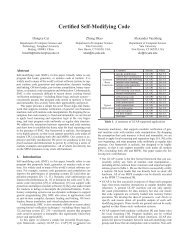
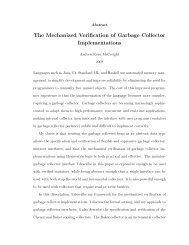
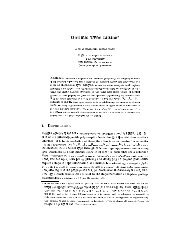
![A Tutorial on [Co-]Inductive Types in Coq - The Flint Project](https://img.yumpu.com/43409031/1/190x245/a-tutorial-on-co-inductive-types-in-coq-the-flint-project.jpg?quality=85)
